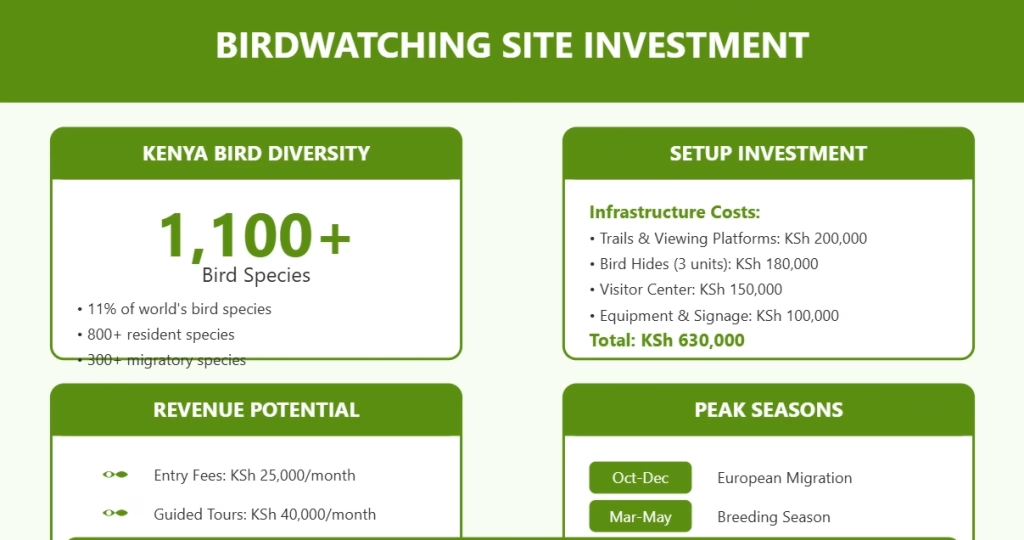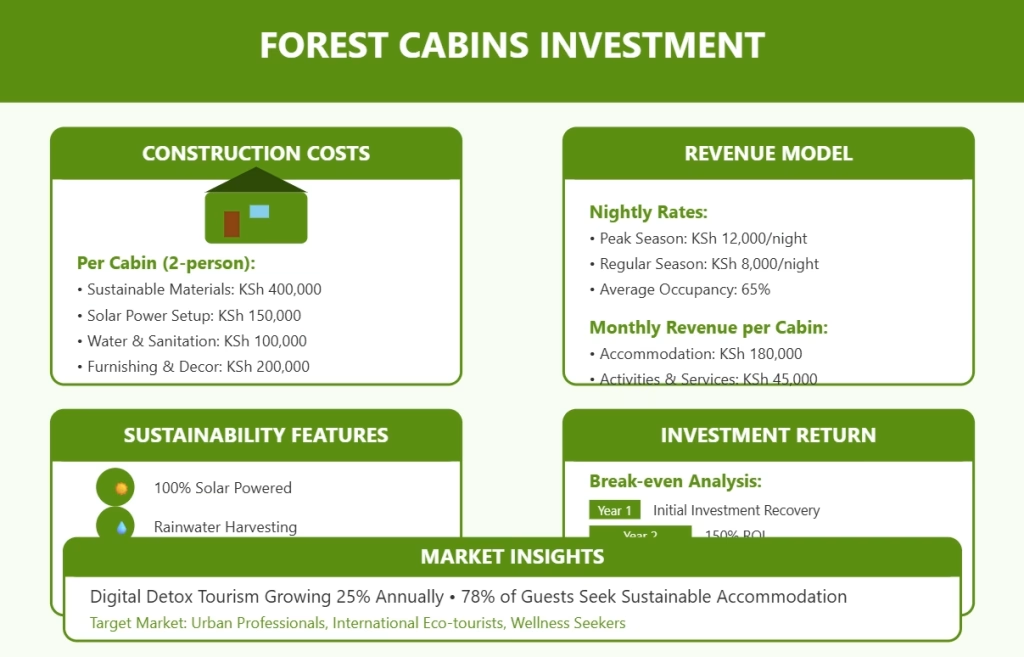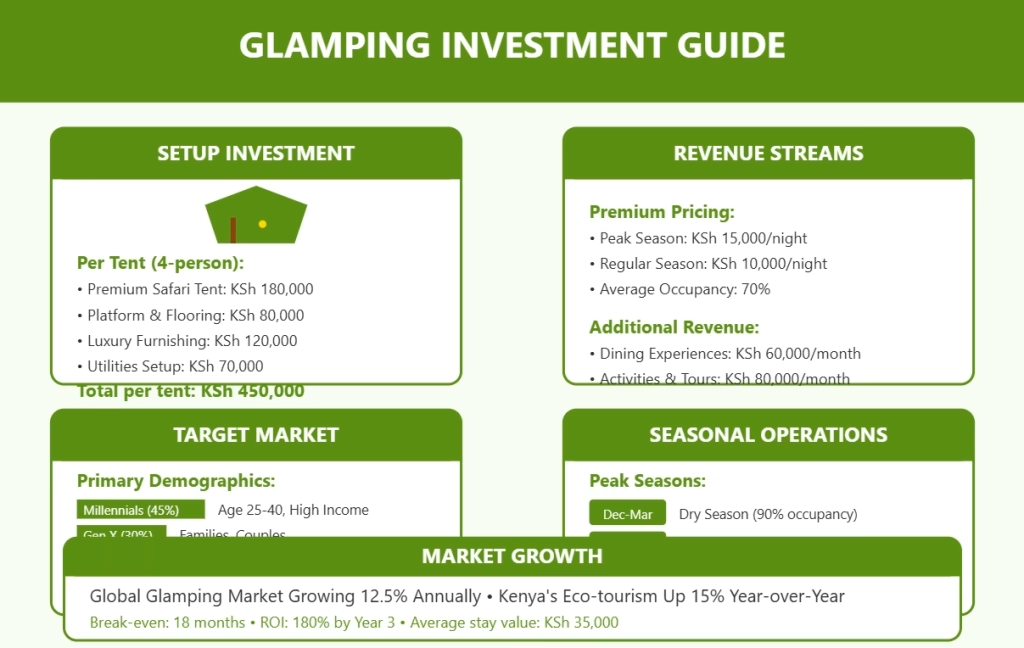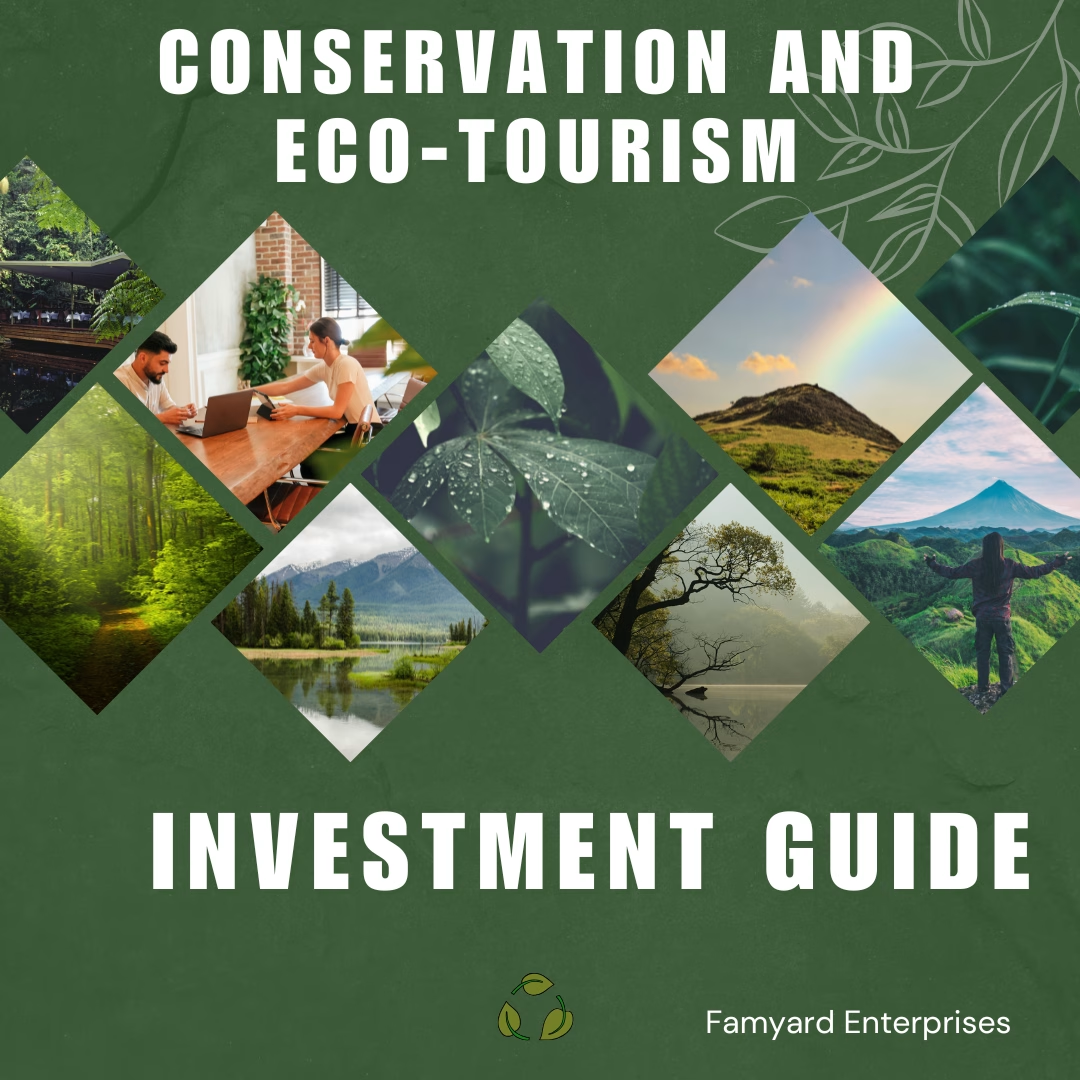The intersection of conservation and eco-tourism with commerce has never been more promising. As travelers increasingly seek authentic, sustainable experiences, eco-tourism presents compelling investment opportunities that benefit both the environment and your bottom line. Kenya’s diverse ecosystems, from the highlands of Mount Kenya to the coastal forests of the Indian Ocean, provide the perfect backdrop for ventures that celebrate nature while generating sustainable income.
Conservation-Based Tourism Economy
Kenya’s tourism sector contributes approximately 10% to the country’s GDP, with eco-tourism representing one of the fastest-growing segments. Unlike traditional tourism models that often strain local resources, conservation-based tourism creates economic value through environmental protection. This approach addresses the growing demand from conscious travelers willing to pay premium prices for experiences that align with their values.
Modern eco-tourists are not just looking for accommodation; they want immersive experiences that connect them with nature and local communities. This shift in consumer behavior creates opportunities for innovative entrepreneurs to develop tourism products that generate revenue while actively contributing to conservation efforts.
Top 5 Conservation and Eco-Tourism Land Investment Ideas for Kenyan Entrepreneurs
Bee Farming
Bee farming, or apiculture, represents one of the most accessible entry points into conservation-based tourism. Beyond honey production, bee farms offer unique educational and experiential opportunities that attract visitors seeking authentic agricultural experiences.
Setting up a bee farm requires a relatively modest initial investment, with basic equipment including hives, protective gear, and processing facilities. The key to success lies in positioning your operation as an educational destination rather than just a production facility. Visitors are fascinated by the intricate social structure of bee colonies, the pollination process, and the journey from hive to honey jar.

Revenue streams from bee farming tourism include guided tours, honey tasting sessions, hands-on beekeeping workshops, and retail sales of honey and bee products. Many successful operations also offer adopt-a-hive programs where visitors can sponsor a hive and receive regular updates and honey harvests.
Location selection is crucial for bee farming ventures. Areas with diverse flowering plants, minimal pesticide use, and proximity to tourist routes offer the best potential. The Rift Valley, Central Kenya, and parts of the Coast Province provide ideal conditions for apiary operations.
Marketing your bee farm requires emphasis on the conservation message. Bees are essential pollinators responsible for approximately one-third of global food production. By visiting and supporting bee farms, tourists directly contribute to biodiversity conservation and food security initiatives.
Birdwatching Sites
Kenya hosts over 1,100 bird species, making it one of the world’s premier birdwatching destinations. Developing specialized birdwatching sites taps into a dedicated global community of enthusiasts who travel extensively and spend significantly on their hobby.
Creating a successful birdwatching site requires understanding both avian behavior and visitor expectations. The best locations feature diverse habitats within relatively small areas, allowing visitors to observe multiple species without extensive travel. Water sources, forest edges, and areas with varied elevation create natural birding hotspots.
Infrastructure needs are minimal but specific. These include well-maintained trails, strategically placed bird hides, and comfortable viewing platforms that enhance the visitor experience. Providing high-quality binoculars and field guides for rent generates additional revenue while improving visitor satisfaction.
Moreover, professional guide services are essential for the success of birdwatching sites. Knowledgeable guides who can identify species by sight and sound, understand bird behavior, and share ecological insights transform casual observers into passionate advocates for conservation. Training local community members as specialized bird guides creates employment opportunities while preserving traditional ecological knowledge.

Revenue generation extends beyond entrance fees to include guided tours, photography workshops, equipment rental, and specialized birding packages. Many sites also offer early morning and evening sessions when bird activity peaks, allowing for premium pricing during these optimal viewing times.
Seasonal variations in bird populations create opportunities for targeted marketing. Migration periods, breeding seasons, and specific weather conditions affect bird behavior and visibility. Successful birdwatching sites develop calendars highlighting optimal viewing times for different species, encouraging repeat visits throughout the year.
Forest Cabins
Forest cabins represent the perfect blend of comfort and conservation, offering visitors immersive nature experiences without sacrificing basic amenities. These accommodations appeal to travelers seeking respite from urban environments while maintaining a connection to modern conveniences.
Sustainable construction practices are fundamental to forest cabin development. Using locally sourced materials, renewable energy systems, and minimal-impact building techniques ensures that accommodations enhance rather than detract from the natural environment. Solar panels, rainwater harvesting, and composting toilets demonstrate environmental commitment while reducing operational costs.
Cabin design should maximize connection with the surrounding forest while ensuring guest comfort. Large windows, covered outdoor spaces, and elevated platforms allow visitors to observe wildlife and enjoy forest sounds without disturbing natural habitats. Interior furnishings crafted from sustainable materials reinforce the conservation message while supporting local artisans.
Location selection requires balancing accessibility with seclusion. Cabins should be easily reachable by standard vehicles but positioned to provide privacy and immersion in nature. Proximity to trails, water features, and wildlife viewing areas enhances the guest experience while encouraging longer stays.

Activity programming differentiates forest cabins from standard accommodations. Guided nature walks, wildlife tracking, star-gazing sessions, and traditional craft workshops create memorable experiences that justify premium pricing. Many successful operations also offer forest bathing sessions, meditation experiences, and outdoor yoga classes.
Marketing forest cabins requires emphasis on digital detox and wellness benefits. Urban dwellers increasingly seek opportunities to disconnect from technology and reconnect with nature. Positioning cabins as wellness retreats rather than simple accommodations appeals to this growing market segment.
Glamping
Glamping, or glamorous camping, removes barriers that prevent many travelers from experiencing nature directly. By combining outdoor adventure with luxury amenities, glamping sites attract visitors who might otherwise avoid traditional camping experiences.
Tent selection and setup are crucial for glamping success. High-quality canvas tents with proper flooring, comfortable bedding, and weather protection create the foundation for positive guest experiences. Incorporating traditional African design elements and locally crafted furnishings adds cultural authenticity while supporting local artisans.
Utility infrastructure must balance convenience with environmental responsibility. Solar-powered lighting, composting toilets, and shared bathroom facilities maintain comfort while minimizing environmental impact. Central dining areas and lounges encourage social interaction while reducing individual resource consumption.

Site selection for glamping operations requires careful consideration of environmental impact and guest experience. Locations should offer natural beauty, wildlife viewing opportunities, and interesting geographical features while ensuring minimal disruption to existing ecosystems. Elevated platforms protect sensitive ground areas while providing enhanced views.
Activity integration distinguishes glamping from traditional camping. Successful sites offer curated experiences such as guided walks, cultural performances, traditional cooking classes, and conservation education programs. These activities create additional revenue streams while deepening guest appreciation for local environments and cultures.
Seasonal operations often work best for glamping sites, allowing natural areas to recover during off-peak periods while concentrating marketing efforts during optimal weather conditions. This approach also enables operators to refresh and maintain facilities during closure periods.
Implementation Strategies and Investment Considerations
Successful conservation-based tourism ventures require comprehensive planning and realistic investment projections. Initial costs vary significantly based on location, scale, and amenity levels, but most operations require 12-24 months to achieve profitability.
Regulatory compliance is essential for all eco-tourism ventures. Environmental impact assessments, tourism licensing, and local authority approvals ensure legal operation while demonstrating a commitment to responsible development. Engaging with the Kenya Wildlife Service, the National Environment Management Authority, and relevant county governments early in the planning process prevents costly delays.
Community engagement is crucial for long-term success. Local communities should be involved as stakeholders, employees, and partners rather than mere beneficiaries. This approach ensures cultural sensitivity, provides local employment opportunities, and creates advocates for conservation efforts.
Marketing strategies should leverage digital platforms while maintaining authentic messaging. Social media presence, professional photography, and guest testimonials build credibility and attract target audiences. Partnerships with international tour operators, eco-tourism organizations, and conservation groups expand market reach while reinforcing conservation credentials.
Financial planning must account for seasonal variations in tourism demand, weather-related challenges, and ongoing conservation commitments. Diversifying revenue streams through multiple activities, retail sales, and partnership arrangements provides stability during challenging periods.
Market Trends and Future Opportunities
- Technology integration- Mobile apps providing species identification, GPS-enabled trail guides, and virtual reality experiences extend engagement beyond physical visits. These tools also generate valuable data about visitor preferences and wildlife populations.
- Carbon offset programs and sustainability certifications– With these standard expectations, operators who proactively address environmental impact through measurable conservation actions gain competitive advantages in marketing and pricing.
- International partnerships- Partnerships with conservation organizations, research institutions, and sustainable tourism networks provide access to funding, expertise, and marketing channels. These relationships also enhance credibility with environmentally conscious travelers who research thoroughly before booking.
- Climate change adaptation strategies- Successful operations must plan for changing weather patterns, shifting wildlife populations, and evolving ecosystem conditions. This requires flexibility in programming, infrastructure design, and conservation approaches.
The integration of conservation and tourism creates powerful economic incentives for environmental protection while providing sustainable livelihoods for local communities. As demand for authentic, responsible travel experiences continues growing, entrepreneurs who can successfully balance conservation goals with visitor satisfaction will find abundant opportunities in Kenya’s diverse landscapes.
